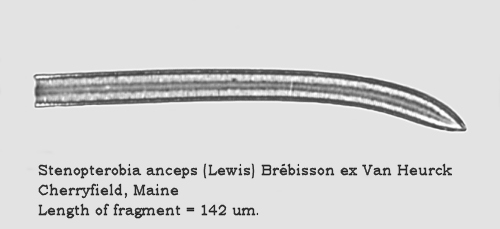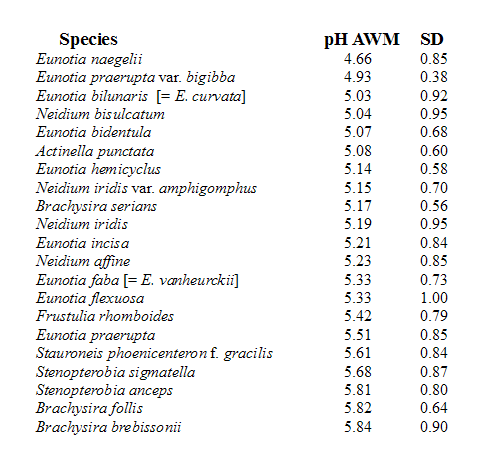
|
Fossil
Freshwater Diatoms from Cherryfield, Maine
Richard T. Carter, Hebei Normal University, Shijiazhuang, China |
The small town of Cherryfield, Maine, is in Washington County, in the southeastern corner of the state. It is located on the Narraguagus River, approximately six miles above its confluence with the sea. This locality was well-known to diatomists of the 19th Century as a source of fossil diatoms, as attested by the numerous antique microscope slides that bear the Cherryfield name on their labels. Several other localities in Maine, such as Beddington, Jonesport, Monmouth, and Orono River, were also known as sources of fossil diatoms, but slides from Cherryfield are definitely more abundant in today’s antique slide market. For those like myself, lacking access to a good research library, it is surprisingly difficult to locate any information on the nature of these deposits, however. Slides from several of these Maine localities, including Cherryfield, were among those offered by Tempère and Peragallo in their Diatomées du Monde Entier collection, where they were identified as being fossil freshwater deposits. Patrick and Reimer (1966:389) cited Cherryfield as the type locality for Neidium tumescens (Grunow in Schmidt) Cleve, described in 1877. Until this past year, that constituted the full extent of my knowledge of this locality.
About a year ago I had the opportunity to purchase two slides from an old Cherryfield sample, mounted by Robert I. Firth in April, 1970. I bought the slides, and have been fascinated by them ever since. The two slides are a bit different, in that one is labeled “large” and the other is labeled “small”; Firth obviously split the sample into two size fractions. The fascination of these slides derives from what they contain, obviously. Having worked a lot with samples of both recent and fossil diatoms from the American Prairies, Great Plains, and Southwest, I was startled by the Cherryfield slides, not only by the suite of species to be seen, but also by what they seem to “lack”. Fossil freshwater diatoms typically accumulate in lake sediments, and one expects to see the full gamut of lacustrine environments represented: planktonic forms, epiphytic forms, epipelic forms, etc. Cherryfield diatoms are different!
First, there are no centric diatoms at all. The Stephanodiscus, Cyclotella, and Aulacoseira species that the Midwesterner expects to find are simply not there. No planktonic pennate forms are to be found, either; no Asterionella, no Fragilaria, no Synedra. The usual plethora of such epiphytes as Cocconeis, Epithemia, and Rhopalodia are also not to be seen. Epipelic forms like Gyrosigma and Nitzschia are lacking. Navicula and Caloneis species are quite rare (with one exception, see below). There are few species of Cymbella and Encyonema, although the species that are present may be fairly common. So, what does that leave, you might ask?
I have thus far identified 64 taxa of diatoms on these two slides, among which are 17 taxa of Eunotia, 16 Pinnularia, 7 Neidium, 4 Brachysira, 3 Frustulia, and 2 Stenopterobia, plus the “telltale” species Actinella punctata Lewis. What the majority of these taxa have in common is a set of ecological preferences not commonly encountered in the American Midwest or Great Plains: they prefer water with a low pH and low conductance, and a high percentage of dissolved humates. They are primarily calciophobic, and sphagnophiles. (Cf. Patrick and Reimer 1966:42, 48.) We seem to be looking at diatoms that accumulated in a bog!1
The age of the deposit is most probably Holocene, since bogs in the northern United States commonly developed in terrain formerly covered by glaciers – often in glacial kettles, where large blocks of stagnant ice melted to form relatively shallow, water-filled depressions. This cool, shallow-water environment would be invaded by Sphagnum mosses, whose accumulation would begin to produce the acidic, dystrophic conditions that this diatom community so clearly reveals.2

Figure 1.
Figure 1 shows Neidium tumescens (Grunow in Schmidt) Cleve. As mentioned above, Cherryfield is the type locality for this taxon, and it is fairly common there. Figures 2 and 3 show N. affine (Ehrenberg) Pfitzer and N. bisulcatum (Lagerstedt) Cleve, species that are fairly cosmopolitan in low-pH environments.

Figure 2.

Figure 3.
Of perhaps more interest are two Neidium species that are endemic to the northeastern quadrant of North America, N. boyeri Reimer and N. temperei Reimer, Figures 4 and 5. The latter species is one of the group in which the proximal raphe ends are straight, rather than being hooked in opposite directions, as seen in the great majority of the commoner Neidium species.

Figure 4.

Figure5.
The only common member of the genus Navicula at Cherryfield is the curious N. monmouthiana-stodderi Yermoloff, so-named because it was thought to form an evolutionary “bridge” between N. monmouthiana Grunow in Cleve and Grunow, and Encyonopsis stodderi (Cleve) Krammer. Figure 6 shows this species, which does indeed look like an Encyonopsis. Although first mentioned and figured by Yermoloff in a very curious paper in 1918 (Yermoloff 1918: 418, Plate 27, figs. 3-4), valid publication of the taxon was not achieved until it was more fully described in Zanon 1930, according to the diatom names database at the California Academy of Sciences.3

Figure 6.
Figures 7, 8, and 9 show three species of Brachysira that are common at Cherryfield, all notably acidophiles. (The fourth Brachysira species common at Cherryfield, B. vitrea (Grunow) R. Ross, is apparently pH indifferent.) Note the prominent “Voigt faults” in these species, a character that they share with most species of Neidium.

Figure 7.

Figure 8.

Figure 9.
The three species of Frustulia are clearly distinct, although I cannot put a name to the one I am calling Frustulia sp. A. The size ranges of these species do not overlap, and each has a characteristic valve outline. Frustulia sp. A is additionally distinguished by its lack of the porte-crayon, the typical “pencil point” that appears at the distal raphe ends of most members of this genus. Figures 10, 11, and 12 illustrate each of these taxa.

Figure 10.

Figure 11.

Figure 12.
Figure 13 shows Actinella punctata Lewis, a species well-known for its preference for dystrophic water and bog environments. It occurs widely, in proper conditions, in eastern North America, and is also known from northern Europe.

Figure 13.
Members of the genus Eunotia are illustrated in Figures 14 through 18. Figure 16 shows E. hemicyclus (Ehrenberg) Ralfs in Pritchard, a species that has been shuffled about through a number of different genera because of an earlier belief that it was an araphid. The discovery that it does, in fact, possess a raphe has cleared the way for its proper inclusion in Eunotia.

Figure 14.

Figure 15.

Figure 16.

Figure 17.

Figure 18.
The genus Stauroneis is represented by two taxa, S. phoenicenteron (Nitzsch) Ehrenberg and S. phoenicenteron f. gracilis (Ehrenberg) Hustedt. Although the former is seemingly pH indifferent, the latter form, illustrated in Figure 19, is an acidophile.

Figure 19.
The surirellacean genus Stenopterobia has few species, and all prefer dystrophic water. Two species (Figures 20 and 21) are found at Cherryfield, the North American endemic S. anceps (Lewis) Brébisson ex Van Heurck, and the more widely distributed S. sigmatella (Gregory) R. Ross in Hartley.4

Figure 20.

Figure 21.
To show the acidophilic nature of this diatom community, I have constructed the following table, based on data from Table 5 in Camburn and Charles (2000: 139-143). This table shows the pH preference of various diatom species found at Cherryfield, in terms of their Abundance Weighted Means (AWM) and standard deviations (SD) in the low-alkalinity lakes of the PIRLA project, from Adirondack Park in northern New York.

It is interesting to note that the nominate form of Stauroneis phoenicenteron, in contrast to the form gracilis, has a pH AWM of 6.57 with a SD of 0.78, making it essentially circumneutral.
Comments to the author, Richard Carter, would be most welcome! In addition, should anyone care to see a full list of the diatoms I have identified from Cherryfield, I can easily provide one through an e-mail attachment.
Notes
1. Not meaning the bog of an English or Irish pub; the waters of those environments tend more toward the alkaline……
2. I have collected a somewhat similar suite of diatoms from a current Sphagnum bog near the headwaters of Rapid Creek in the northern Black Hills of South Dakota. That bog is a bit different, in that it formed on a small flat area on a spring-fed, wet alpine slope in Ponderosa Pine forest.
3. The 1918 Yermoloff paper, with its rather peculiar understanding of Darwinian evolution, remarks on the destruction of Atlantis, analogies between mathematical calculus and biological taxonomy, etc., makes very entertaining reading! It is interesting, however, that Yermoloff recognized clearly the taxonomic unity of many of the forms that have been recently transferred to the new genus Encyonopsis.
4. A junior synonym of the latter is S. curvula (W. Smith) Krammer.
References
Camburn, Keith E. and Donald F. Charles, 2000, Diatoms of Low-alkalinity Lakes in the Northeastern United States, The Academy of Natural Sciences of Philadelphia, Special Publication 18.
Patrick, Ruth and Charles W. Reimer, 1966, The Diatoms of the United States (Exclusive of Alaska and Hawaii), Volume 1, The Academy of Natural Sciences of Philadelphia, Monograph 13.
Yermoloff, Sir Nicholas, 1918, “Notes on Some Intermediate Forms of the Genera Navicula and Cymbella,” Journal of the Quekett Microscopical Club, Series 2, Volume XII, pp. 407-424, Plates 26-28.
Microscopy UK Front Page
Micscape Magazine
Article Library
Please report any Web problems or offer general comments to the Micscape Editor.
Micscape is the on-line monthly magazine of the Microscopy UK web site at Microscopy-UK.